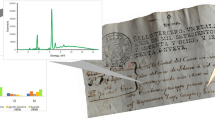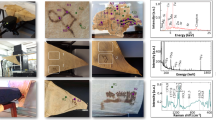Abstract
A method has been developed for identification of corrosive iron–gall inks in historical drawings and documents. The method is based on target-factor analysis of visible–near infrared fibre optic reflection spectra (VIS–NIR FORS). A set of reference spectra was obtained from model samples of laboratory-prepared inks covering a wide range of mixing ratios of basic ink components deposited on substrates and artificially aged. As criteria for correspondence of a studied spectrum with a reference spectrum, the apparent error in target (AET) and the empirical function SPOIL according to Malinowski were used. The capability of the proposed tool to distinguish corrosive iron–gall inks from bistre and sepia inks was evaluated by use of a set of control samples of bistre, sepia, and iron–gall inks. Examples are presented of analysis of historical drawings from the 15th and 16th centuries and written documents from the 19th century. The results of analysis based on the tool were confirmed by XRF analysis and colorimetric spot analysis.

Sitting Evangelist, Bartolomeo Passarotti, 16th century, Slovak National Gallery, Bratislava, Slovak Republic, Inventory No. K 96











Similar content being viewed by others
References
Corrigan C (1997) Drawing Techniques. In: Cohn M (ed) Old Master Prints and Drawings – A Guide to Preservation and Conservation. Amsterdam University Press, Amsterdam, p 76
Banik G (1997) Decay caused by iron–gall inks. In: van der Windt E (ed) Proceedings Workshop on Iron–gall Ink Corrosion, Rotterdam. Museum Boijmans Van Beuningen and Netherlands Institute for Cultural Heritage, Rotterdam, pp 21–27
Strlič M, Simon Šelih V, Kola J (2006) Model Studies of the Catalytic Role of Transition Metals. In: Kolar J, Strlič M (eds) Iron–gall Inks: On Manufacture, Characterization, Degradation and Stabilization. Narodna i univerzitetna knjižnica, Ljubljana, pp 173–180
Reissland B (2000) Visible progress of paper degradation caused by Iron–gall Inks. In: Brown AJE (ed) The Postprints of the Iron–gall Ink Meeting. University of Northumbria, Newcastle-upon-Tyne, pp 67–72
Goltz DM (2012) A Review of Instrumental Approaches for Studying Historical Inks. Anal Lett 45:314–328
Neevel JG (2006) The Development of In-Situ Methods for Identification of Iron–gall Inks. In: Kolar J, Strlič M (eds) Iron–gall Inks: On Manufacture, Characterization, Degradation and Stabilization. Narodna i univerzitetna knjižnica, Ljubljana, pp 147–172
Kecskeméti I (2005) False Colour Infrared (FCIR) Imaging with Standard Digital Camera, in Transitional Metals in Paper, 7th International Symposium. Book of Abstracts, University of Rome “La Sapienza”, Rome
Havermans J, Abdul Aziz H, Scholten H (2003) Non Destructive Detection of Iron Gall Inks by Means of Multispectral Imaging. (Part 2), Restaurator 24, pp 88–94
Sjostrom E (1993) Wood Chemistry: Fundamentals and Applications, 2nd edn. Academic Press, San Diego, ISBN 0-12-647481-8
ISO 5630-5 (2006) Paper and board – Accelerated ageing, Part 5: Exposure to elevated temperature at 100 °C
Čeppan M, Fedák J, Dvonka V, Veselý M, Zmeskal O (2003) J Image Sci Technol 47:171
Malinowski ER (2002) Factor Analysis in Chemistry (Third Edition). John Wiley and Sons, Inc., New York
Pelikán P, Čeppan M, Liška M (1994) Application of Numerical methods in Molecular Spectroscopy. CRC Press, Boca Raton
Tarajčáková J (2010) Identification and Analysis of Drawing Techniques of Selected Art Pieces from the Collection of Drawings of the Slovak National Gallery in Bratislava, PhD Thesis, Academy of Fine Arts and Design in Bratislava, Slovakia, Bratislava
Hebenstreit W (1843) Wissenschaftlich-literarische Encyklopädie der Aesthetik. Strauss and Cramer GmbH (Ed.), Hirschberg
Acknowledgments
We thank the Slovak Scientific Grant Agency Vega for supporting this research (Project Vega 1/0811/11). This work was supported by the Slovak Research and Development Agency under the contract no. APVV-0324-10. This publication is the result of the project implementation: ITMS: 26240120016 supported by the Research and Development Operational Programme funded by the ERDF.
Author information
Authors and Affiliations
Corresponding author
Rights and permissions
About this article
Cite this article
Gál, L., Čeppan, M., Reháková, M. et al. Chemometric tool for identification of iron–gall inks by use of visible–near infrared fibre optic reflection spectroscopy. Anal Bioanal Chem 405, 9085–9091 (2013). https://doi.org/10.1007/s00216-013-7333-z
Received:
Revised:
Accepted:
Published:
Issue Date:
DOI: https://doi.org/10.1007/s00216-013-7333-z




